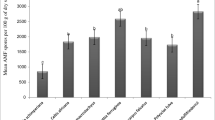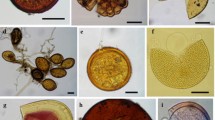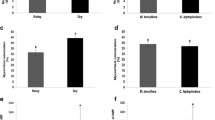Abstract
Hyphae and vesicles of arbuscular mycorrhizal fungi (AMF) were found within the decomposing leaves of Myrica parvifolia, M. pubescens and Paepalanthus sp. at three montane sites in Colombia. Hyphae, vesicles, and arbuscule-like structures were also found within scale-like leaves of the rhizomes of Paepalanthus sp. The litter found in the vicinity of the roots was divided into three decomposition layers. The highest AMF colonization occurred in the most decomposed leaves, which were in close association with roots. In contrast, there were no differences in AMF colonization of roots present in the different decomposition layers. Colonization of decomposing leaves by AMF did not differ between the two closely related species M. parvifolia and M. pubescens, nor between two sites (Guatavita and Zipacón, Colombia) differing in soil fertility. Occurrence of vesicles in decomposing leaves was correlated with abundant AMF extraradical hyphae among the leaves. We propose that AMF enter decomposing leaves mechanically through vascular tissue. As a consequence, AMF are well positioned to obtain and efficiently recycle mineral nutrients released by decomposer microorganisms before their loss by leaching or immobilization in soil.

Similar content being viewed by others
References
Abbott LK, Robson AD (1991) Factors influencing the occurrence of vesicular-arbuscular mycorrhizas. Agric Ecosyst Environ 35:121–150
Bravo A, Castillo A, Chaves G (1996) Evaluación de 3 métodos sobre la pregerminación de semillas del laurel de cera. BSC thesis, Universidad Autónoma Nacional, Pasto, Colombia
Díaz L (2001) Presencia de hongos similares a los de micorriza arbuscular en hojarasca de cultivos de Coffea arabica L. en sistemas agrícolas diferentes. MSc thesis, Pontificia Universidad Javeriana, Bogotá, Colombia
Dix N, Webster J (1995) Fungal ecology. Chapman & Hall, London
Fischer C, Janos D, Perry D, Linderman R, Sollins P (1994) Mycorrhiza inoculum potentials in tropical secondary succession. Biotropica 26:369–377
Friese C, Allen M (1991) The spread of VA mycorrhizal fungal hyphae in the soil: inoculum types and external hyphal architecture. Mycologia 83:409–418
Gerdemann J, Nicholson T (1963) Spores of mycorrhizal Endogone species extracted from soil by wet sieving and decanting. Trans Br Mycol Soc 46:235–244
Hall J, Flowers T, Roberts R (1981) Plant cell structure and metabolism, 2nd edn. Longman, New York
Herrera R, Merida T, Stark N, Jordan C (1978) Direct phosphorus transfer from leaf litter to roots. Naturwissenschaften 65:208–209
Herrera R, Rodriguez A, Furrazola E (1986) Método para determinar la biomasa de micelio extramátrico vesiculo-arbuscular. In: Ciclo lectivo sobre el tema: Técnicas de investigación en micorriza. Turrialba, Costa Rica 18–28 Septiembre 1985. Fundación Internacional para la Ciencia, Estocolomo, Suecia, pp 197–207
Hodge A, Robinson D, Griffiths BS, Fitter AH (1999) Why plants bother: root proliferation results in increased nitrogen capture from an organic patch when two grasses compete. Plant Cell Environ 22:811–820
Hodge A, Campbell C, Fitter AH (2001) An arbuscular mycorrhizal fungus accelerates decomposition and acquires nitrogen directly from organic material. Nature 413:297–299
Imhof S (2001) Subterranean structures and mycotrophy of the achlorophyllous Dictyostega orobanchoides (Burmanniaceae). Rev Biol Trop 49:239–247
Janos D (1983) Tropical mycorrhizas, nutrient cycles and plant growth. In: Sutton S, Whitmore T, Chadwick A (eds) Tropical rain forest: ecology and management. Blackwell, Oxford, UK, pp 327–345
Janos D (1987) VA mycorrhizas in humid tropical ecosystems. In: Safir G (ed) Ecophysiology of VA mycorrhizal plants. CRC, Boca Raton, Fla, pp 107–134
Jeffries P, Barea J (1994) Biogeochemical cycling and arbuscular mycorrhizas in the sustainability of plant-soil systems. In: Gianinazzi S, Schuepp H (eds) Impact of arbuscular mycorrhizas on sustainable agriculture and natural ecosystems. Birkhäuser, Basel, Switzerland, pp 101–116
Jenkins W (1964) A rapid centrifugal-flotation technique for separating nematodes from soil. Plant Dis Rep 48:692
Koske R (1984) Spores of vesicular-arbuscular mycorrhizal fungi inside spores of vesicular-arbuscular mycorrhizal fungi. Mycologia 76:853–862
Linderman R (1992) Vesicular-arbuscular mycorrhizae and soil microbial interactions. In: Bethlenfalvay G, Linderman R (eds) Mycorrhizae in sustainable agriculture. ASA Special Publication No. 54, Madison, Wis, pp 45–70
Maffia B, Nadkarni NM, Janos DP (1993) Vesicular-arbuscular mycorrhizae of epiphytic and terrestrial Piperaceae under field and greenhouse conditions. Mycorrhiza 4:5–9
McGonigle TP, Miller MH, Evans DG, Fairchild GL, Swan JA (1990) A new method which gives an objective measure of colonization of roots by vesicular-arbuscular mycorrhizal fungi. New Phytol 115:495–501
McKee KL (2001) Root proliferation in decaying roots and old root channels: a nutrient conservation mechanism in oligotrophic mangrove forests? J Ecol 89:876–887
Meyer J, Linderman R (1986) Selective influence on populations of rhizosphere or rhizoplane bacteria and actinomycetes by mycorrhizas formed by Glomus fasciculatum. Soil Biol Biochem 18:191–196
Mosse B, Hepper C (1975) Vesicular-arbuscular infections in root organ cultures. Physiol Plant Pathol 5:215–223
Nadkarni N (1981) Canopy roots: convergent evolution in rainforest nutrient cycles. Science 214:1023–1024
Nicolson T (1959) Mycorrhiza in the Gramineae. I. Vesicular-arbuscular endophytes, with special reference to the external phase. Trans Br Mycol Soc 42:421–438
Pabón A (2000) Presencia de estructuras similares a las que componen el hongo de micorriza arbuscular en hojarasca de Cedrela montana Turczaninov. BSC thesis, Pontificia Universidad Javeriana, Bogotá, Colombia
Parra CA (1998) Taxonomía del género Myrica (Myricaceae) en Colombia. BSC thesis, Pontificia Universidad Javeriana, Bogotá, Colombia
Parra A, Proano C, Arevalo D, Rodriguez C (1985) Estudio general de suelos del oriente de Cundinamarca y municipio de Umbita. Instituto Geográfico Agustín Codazzi, Bogotá, Colombia
Phillips J, Hayman D (1970) Improved procedure for clearing roots and staining parasitic and vesicular-arbuscular mycorrhizal fungi for rapid assessment of infection. Trans Br Mycol Soc 55:158–161
Rabatin S, Rhodes L (1982) Acaulospora bireticulata inside Oribatid mites. Mycologia 74:859–861
Rabatin S, Stinner B, Paoletti M (1993) Vesicular-arbuscular mycorrhizal fungi, particularly Glomus tenue, in Venezuelan bromeliad epiphytes. Mycorrhiza 4:17–20
Racette S, Torrey JG, Berg RH (1991) Sporulation in root nodules of actinorhizal plants inoculated with pure cultured strains of Frankia. Can J Bot 69:1471–1476
Read D (1992) The mycorrhizal mycelium. In: Allen M (ed) Mycorrhizal functioning: an integrative plant-fungal process. Chapman & Hall, New York, pp 102–133
Reddell P, Hopkins M, Graham A (1996) Functional association between apogeotropic roots, mycorrhizas and paper-barked stems in a lowland tropical rainforest in North Queensland. J Trop Ecol 12:763–777
Richards PW (1996) The tropical rain forest, 2nd edn. Cambridge University Press, Cambridge, UK
Rivera E, Guerrero E (1998) Ciclaje directo de nutrientes a través de endomicorriza. Un complemento del proceso de mineralización? In: Congres Mondial de Science Dusol, 20–26 August 1998, Montpellier, France
Rose S, Paranka J (1987) The location of roots and mycorrhizae in tropical forest litter. In: Sylvia D, Hung L, Graham J (eds) Mycorrhizae in the next decade: practical applications and research priorities. Institute of Food and Agricultural Sciences, University of Florida, Gainesville, Fla, p 165
Sanford R (1987) Apogeotropic roots in an Amazon rain forest. Science 235:1062–1064
Scheiner S (1993) MANOVA: multiple response variables and multispecies interactions. In: Scheiner S, Gurevitch J (eds) Design and analysis of ecological experiments. Chapman & Hall, New York, pp 94–112
Smith S, Read D (1997) Mycorrhizal symbiosis, 2nd edn. Academic, San Diego, Calif
St John T, Coleman D, Reid C (1983) Association of vesicular-arbuscular mycorrhizal hyphae with soil organic particles. Ecology 64:957–959
Sturm H, Rangel O (1985) Ecología de los páramos Andinos: Una visión preliminar integrada. Instituto de Ciencias Naturales, Universidad Nacional de Colombia, Bogotá
Taber R (1982a) Gigaspora spores and associated hyperparasites in weed seeds in soil. Mycologia 74:1026–1031
Taber R (1982b) Occurrence of Glomus spores in weed seeds in soil. Mycologia 74:515–520
Taber R, Strong M (1982) Vesicular-arbuscular mycorrhiza in roots and xylem of Tradescantia. Mycologia 74:152–156
Taber R, Trappe J (1982) Vesicular-arbuscular mycorrhiza in rhizomes, scale-like leaves, roots, and xylem of ginger. Mycologia 74:156–161
vanVuuren MMI, Robinson D, Griffiths BS (1996) Nutrient inflow and root proliferation during the exploitation of a temporally and spatially discrete source of nitrogen in soil. Plant Soil 178:185–192
Varma A (1999) Hydrolytic enzymes from arbuscular mycorrhizae: the current status. In: Varma A, Hock B (eds) Mycorrhiza, 2nd edn. Springer, Berlin Heidelberg New York, pp 373–389
Went F, Stark N (1968a) Mycorrhiza. Bioscience 18:1035–1039
Went F, Stark N (1968b) The biological and mechanical role of soil fungi. Proc Natl Acad Sci USA 60:497–504
Acknowledgements
This research was financed by COLCIENCIAS and Pontificia Universidad Javeriana (PUJ, Colombia). The authors are grateful to Carlos Parra for help in plant identification, and to A. Varela and the Population Ecology Lab at PUJ for facilitating sampling at Zipacón.
Author information
Authors and Affiliations
Corresponding author
Rights and permissions
About this article
Cite this article
Aristizábal, C., Rivera, E.L. & Janos, D.P. Arbuscular mycorrhizal fungi colonize decomposing leaves of Myrica parvifolia, M. pubescens and Paepalanthus sp.. Mycorrhiza 14, 221–228 (2004). https://doi.org/10.1007/s00572-003-0259-0
Received:
Accepted:
Published:
Issue Date:
DOI: https://doi.org/10.1007/s00572-003-0259-0




